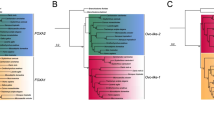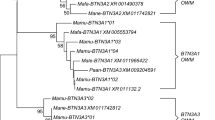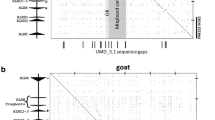Abstract
CD94 forms heterodimers with NKG2A, -C, or –E to constitute lectin-like natural killer cell receptors for MHC-E. Its structure differs from other C-type lectins in that the second α-helix is replaced by a loop that forms the interacting interface with the NKG2 molecules. Although CD94 has remained highly conserved mammals, several alternative splicing variants have been detected in some species. To evaluate the prevalence and significance of this phenomenon, we have cloned and sequenced CD94 cDNAs in six species of New World primates from the Cebidae and Atelidae families. Full-length sequences had a mean similarity of 96 % amongst New World primates and of 90 % to the human orthologue, with little variation in the residues interacting with NKG2 or MHC-E molecules. Despite this high conservation, a total of 14 different splice variants were identified, half of which were shared by two or more primate species. Homology-based modeling of the C-type lectin domain showed that most isoforms folded stably, although they had modifications that prevented its interaction with NKG2 and MHC-E. Two isoforms were predicted to replace the typical CD94 loop by a second α-helix, evidencing a domain fold transition from a CD94 structure to a canonical C-type lectin. These two structures were more similar to members of the CLEC lectin family than to the native CD94. Thus, CD94 has remained conserved in primates to maintain functional interactions with NKG2 and MHC-E, while at the same time has diversified by alternative splicing potentially providing additional functional scenarios.




Similar content being viewed by others
References
Arnold K, Bordoli L, Kopp J, Schwede T (2006) The SWISS-MODEL workspace: a web-based environment for protein structure homology modelling. Bioinformatics 22(2):195–201
Averdam A, Kuhl H, Sontag M, Becker T, Hughes AL, Reinhardt R, Walter L (2007) Genomics and diversity of the common marmoset monkey NK complex. J Immunol 178(11):7151–7161
Averdam A, Petersen B, Rosner C, Neff J, Roos C, Eberle M, Aujard F, Munch C, Schempp W, Carrington M, Shiina T, Inoko H, Knaust F, Coggill P, Sehra H, Beck S, Abi-Rached L, Reinhardt R, Walter L (2009) A novel system of polymorphic and diverse NK cell receptors in primates. PLoS Genet 5(10):e1000688
Barrow AD, Trowsdale J (2008) The extended human leukocyte receptor complex: diverse ways of modulating immune responses. Immunol Rev 224:98–123
Batliner J, Mancarelli MM, Jenal M, Reddy VA, Fey MF, Torbett BE, Tschan MP (2011) CLEC5A (MDL-1) is a novel PU.1 transcriptional target during myeloid differentiation. Mol Immunol 48(4):714–719
Benkert P, Biasini M, Schwede T (2011) Toward the estimation of the absolute quality of individual protein structure models. Bioinformatics 27(3):343–350
Biassoni R, Ugolotti E, De Maria A (2010) Comparative analysis of NK-cell receptor expression and function across primate species: perspective on antiviral defenses. Self Nonself 1(2):103–113
Birzele F, Csaba G, Zimmer R (2008) Alternative splicing and protein structure evolution. Nucleic Acids Res 36(2):550–558
Boyington JC, Riaz AN, Patamawenu A, Coligan JE, Brooks AG, Sun PD (1999) Structure of CD94 reveals a novel C-type lectin fold: implications for the NK cell-associated CD94/NKG2 receptors. Immunity 10(1):75–82
Braud VM, Allan DS, O’Callaghan CA, Soderstrom K, D’Andrea A, Ogg GS, Lazetic S, Young NT, Bell JI, Phillips JH, Lanier LL, McMichael AJ (1998) HLA-E binds to natural killer cell receptors CD94/NKG2A, B and C. Nature 391(6669):795–799
Canavez FC, Moreira MA, Ladasky JJ, Pissinatti A, Parham P, Seuanez HN (1999) Molecular phylogeny of new world primates (Platyrrhini) based on beta2-microglobulin DNA sequences. Mol Phylogenet Evol 12(1):74–82
Carretero M, Cantoni C, Bellon T, Bottino C, Biassoni R, Rodriguez A, Perez-Villar JJ, Moretta L, Moretta A, Lopez-Botet M (1997) The CD94 and NKG2-A C-type lectins covalently assemble to form a natural killer cell inhibitory receptor for HLA class I molecules. Eur J Immunol 27(2):563–567
Cheent K, Khakoo SI (2009) Natural killer cells: integrating diversity with function. Immunology 126(4):449–457
Colovos C, Yeates TO (1993) Verification of protein structures: patterns of nonbonded atomic interactions. Protein Sci 2(9):1511–1519
Delport W, Poon AF, Frost SD, Kosakovsky Pond SL (2010) Datamonkey 2010: a suite of phylogenetic analysis tools for evolutionary biology. Bioinformatics 26(19):2455–2457
Drummond AJ, Rambaut A (2007) BEAST: Bayesian evolutionary analysis by sampling trees. BMC Evol Biol 7:214
Gaudreau MC, Heyd F, Bastien R, Wilhelm B, Moroy T (2012) Alternative splicing controlled by heterogeneous nuclear ribonucleoprotein L regulates development, proliferation, and migration of thymic pre-T cells. J Immunol 188(11):5377–5388
Ghigna C, Valacca C, Biamonti G (2008) Alternative splicing and tumor progression. Curr Genomics 9(8):556–570
Guethlein LA, Flodin LR, Adams EJ, Parham P (2002) NK cell receptors of the orangutan (Pongo pygmaeus): a pivotal species for tracking the coevolution of killer cell Ig-like receptors with MHC-C. J Immunol 169(1):220–229
Hedges SB, Dudley J, Kumar S (2006) TimeTree: a public knowledge-base of divergence times among organisms. Bioinformatics 22(23):2971–2972
Hofer E, Sobanov Y, Brostjan C, Lehrach H, Duchler M (2001) The centromeric part of the human natural killer (NK) receptor complex: lectin-like receptor genes expressed in NK, dendritic and endothelial cells. Immunol Rev 181:5–19
Huelsenbeck JP, Ronquist F (2001) MRBAYES: Bayesian inference of phylogenetic trees. Bioinformatics 17(8):754–755
Humphrey W, Dalke A, Schulten K (1996) VMD: visual molecular dynamics. J Mol Graph 14(1):33–38, 27–38
Jelen N, Ule J, Zivin M, Darnell RB (2007) Evolution of Nova-dependent splicing regulation in the brain. PLoS Genet 3(10):1838–1847
Kaiser BK, Pizarro JC, Kerns J, Strong RK (2008) Structural basis for NKG2A/CD94 recognition of HLA-E. Proc Natl Acad Sci U S A 105(18):6696–6701
Kelley J, Walter L, Trowsdale J (2005) Comparative genomics of natural killer cell receptor gene clusters. PLoS Genet 1(2):129–139
Kelley LA, Sternberg MJ (2009) Protein structure prediction on the Web: a case study using the Phyre server. Nat Protoc 4(3):363–371
Kim DK, Kabat J, Borrego F, Sanni TB, You CH, Coligan JE (2004) Human NKG2F is expressed and can associate with DAP12. Mol Immunol 41(1):53–62
Kimura M (1980) A simple method for estimating evolutionary rates of base substitutions through comparative studies of nucleotide sequences. J Mol Evol 16:111–120
Knapp LA, Cadavid LF, Watkins DI (1998) The MHC-E locus is the most well conserved of all known primate class I histocompatibility genes. J Immunol 160(1):189–196
Labonte ML, Letvin NL (2004) Variable NKG2 expression in the peripheral blood lymphocytes of rhesus monkeys. Clin Exp Immunol 138(2):205–212
LaBonte ML, Levy DB, Letvin NL (2000) Characterization of rhesus monkey CD94/NKG2 family members and identification of novel transmembrane-deleted forms of NKG2-A, B, C, and D. Immunogenetics 51(6):496–499
LaBonte ML, Russo J, Freitas S, Keighley D (2007) Variation in the ligand binding domains of the CD94/NKG2 family of receptors in the squirrel monkey. Immunogenetics 59(10):799–811
Lanier LL (2003) Natural killer cell receptor signaling. Curr Opin Immunol 15(3):308–314
Larkin MA, Blackshields G, Brown NP, Chenna R, McGettigan PA, McWilliam H, Valentin F, Wallace IM, Wilm A, Lopez R, Thompson JD, Gibson TJ, Higgins DG (2007) Clustal W and Clustal X version 2.0. Bioinformatics 23(21):2947–2948
Lieto LD, Maasho K, West D, Borrego F, Coligan JE (2006) The human CD94 gene encodes multiple, expressible transcripts including a new partner of NKG2A/B. Genes Immun 7(1):36–43
Meng EC, Pettersen EF, Couch GS, Huang CC, Ferrin TE (2006) Tools for integrated sequence-structure analysis with UCSF Chimera. BMC Bioinforma 7:339
Modrek B, Lee C (2002) A genomic view of alternative splicing. Nat Genet 30(1):13–19
Moretta L, Mingari MC, Bottino C, Pende D, Biassoni R, Moretta A (2003) Cellular and molecular basis of natural killer and natural killer-like activity. Immunol Lett 88(2):89–93
Perelman P, Johnson WE, Roos C, Seuanez HN, Horvath JE, Moreira MA, Kessing B, Pontius J, Roelke M, Rumpler Y, Schneider MP, Silva A, O’Brien SJ, Pecon-Slattery J (2011) A molecular phylogeny of living primates. PLoS Genet 7(3):e1001342
Petrie EJ, Clements CS, Lin J, Sullivan LC, Johnson D, Huyton T, Heroux A, Hoare HL, Beddoe T, Reid HH, Wilce MC, Brooks AG, Rossjohn J (2008) CD94-NKG2A recognition of human leukocyte antigen (HLA)-E bound to an HLA class I leader sequence. J Exp Med 205(3):725–735
Posada D, Crandall KA (1998) MODELTEST: testing the model of DNA substitution. Bioinformatics 14(9):817–818
Pritsker M, Doniger TT, Kramer LC, Westcot SE, Lemischka IR (2005) Diversification of stem cell molecular repertoire by alternative splicing. Proc Natl Acad Sci U S A 102(40):14290–14295
Raulet DH (2003) Roles of the NKG2D immunoreceptor and its ligands. Nat Rev Immunol 3(10):781–790
Revil T, Gaffney D, Dias C, Majewski J, Jerome-Majewska LA (2010) Alternative splicing is frequent during early embryonic development in mouse. BMC Genomics 11:399
Ronquist F, Huelsenbeck JP (2003) MrBayes 3: Bayesian phylogenetic inference under mixed models. Bioinformatics 19(12):1572–1574
Roy A, Kucukural A, Zhang Y (2010) I-TASSER: a unified platform for automated protein structure and function prediction. Nat Protoc 5(4):725–738
Ryan JC, Seaman WE (1997) Divergent functions of lectin-like receptors on NK cells. Immunol Rev 155:79–89
Saether PC, Hoelsbrekken SE, Fossum S, Dissen E (2011) Rat and mouse CD94 associate directly with the activating transmembrane adaptor proteins DAP12 and DAP10 and activate NK cell cytotoxicity. J Immunol 187(12):6365–6373
Schrago CG (2007) On the time scale of New World primate diversification. Am J Phys Anthropol 132(3):344–354
Shum BP, Flodin LR, Muir DG, Rajalingam R, Khakoo SI, Cleland S, Guethlein LA, Uhrberg M, Parham P (2002) Conservation and variation in human and common chimpanzee CD94 and NKG2 genes. J Immunol 168(1):240–252
Tamura K, Peterson D, Peterson N, Stecher G, Nei M, Kumar S (2011) MEGA5: molecular evolutionary genetics analysis using maximum likelihood, evolutionary distance, and maximum parsimony methods. Mol Biol Evol 28(10):2731–2739
Watson AA, Brown J, Harlos K, Eble JA, Walter TS, O’Callaghan CA (2007) The crystal structure and mutational binding analysis of the extracellular domain of the platelet-activating receptor CLEC-2. J Biol Chem 282(5):3165–3172
Watson AA, Lebedev AA, Hall BA, Fenton-May AE, Vagin AA, Dejnirattisai W, Felce J, Mongkolsapaya J, Palma AS, Liu Y, Feizi T, Screaton GR, Murshudov GN, O’Callaghan CA (2011) Structural flexibility of the macrophage dengue virus receptor CLEC5A: implications for ligand binding and signaling. J Biol Chem 286(27):24208–24218
Acknowledgments
This work was supported by a grant from the Universidad Nacional de Colombia’s Research Division to LFC. Colombia’s Ministry of the Environment and Sustainable Development authorized the access to genetic resources for scientific research without commercial interests (contract No. 1 of 2012).
Author information
Authors and Affiliations
Corresponding author
Additional information
Nucleotide sequence data reported are available in the GenBank database under accession numbers JX170717-JX170743
Rights and permissions
About this article
Cite this article
Galindo, J.A., Cadavid, L.F. High diversification of CD94 by alternative splicing in New World primates. Immunogenetics 65, 281–290 (2013). https://doi.org/10.1007/s00251-013-0685-x
Received:
Accepted:
Published:
Issue Date:
DOI: https://doi.org/10.1007/s00251-013-0685-x




